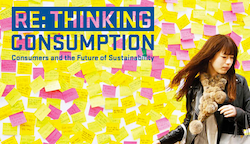 For those in the sustainable products industry, it has been a long running and often elusive challenge to understand the role consumers play in creating a thriving “green” marketplace. During the holiday season when shopping reaches a fever pitch is perhaps the most interesting time to explore what underlies our purchasing decisions and how those decisions compare to those around the globe. The holidays are also a time that can challenge whatever “green” commitments consumers claim to have made. BBMG, GlobeScan and SustainAbility recently released the Regeneration Consumer Study to explore these issues.
For those in the sustainable products industry, it has been a long running and often elusive challenge to understand the role consumers play in creating a thriving “green” marketplace. During the holiday season when shopping reaches a fever pitch is perhaps the most interesting time to explore what underlies our purchasing decisions and how those decisions compare to those around the globe. The holidays are also a time that can challenge whatever “green” commitments consumers claim to have made. BBMG, GlobeScan and SustainAbility recently released the Regeneration Consumer Study to explore these issues.
Consider these selected statistics from the study:
- A remarkable 82% of respondents in developing markets feel a sense of responsibility to purchase products that are good for the environment and society, compared to only 49% of respondents in developed markets who feel that way.
- 60% of respondents in developing markets are “willing to pay more for products with social and environmental benefits,” compared to a mere 26% consumers in developed markets willing to do so.
- Product performance is one of the top barriers to green purchasing for consumers in developing markets, but price is the top barrier in developed markets.
- 66% of respondents across the globe say that “as a society, we need to consume a lot less to improve the environment for future generations,” However, 76% in developing markets say this describes or completely describes them, but only 57% in developed markets were apt to identify with that statement.
- Finally, nearly half of the consumers in developing countries have a very strong aspiration to acquire material goods and believe that material possessions relate to their happiness.
What can we make of these findings? The culture of consumerism in developed countries has been running rampantly out of control for years and those trends are largely stable – price, value and performance are usually the most important considerations when purchasing, while considerations of social good rank quite low.
But in developing countries, the study reveals the emergence of a different pattern. In fact, the group of consumers labeled “aspirationals” – materialistically-oriented consumers who aspire to be sustainable in their purchases and beliefs – is set to grow to the billions in developing countries by the year 2050. They are already the largest category of consumers in Brazil, China and India. The good news is that “aspirational” consumers tend to consider the total value of the product or service: one that offers traditional practical benefits but also negates buyer’s remorse by providing societal and environmental good, and in addition provides the “tribal benefits” that deliver a feeling of connection to others with shared values.
Consumers may want stuff, the study finds, but what they really want is to connect to each other and to the brands that matter to them on a social level. Not surprising then that most consumers trust their social networks for clues into what to purchase rather than company-based claims which are regarded as untrustworthy. The emerging way to guide consumer choice is to create a brand is relatable on a social, personal and value-based level.
Given the findings of this study, it’s easy to feel hopeful that the developing nations’ appetite for consumer goods might not destroy the planet – but only if companies develop responsible products that consumers feel socially connected to. However, the real issue is cultivating this deep connection to social responsibility in developed nations like the United States.
Is it engrained in our culture to disregard the planet over prices? I would love to hear your thoughts on this study.
